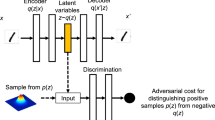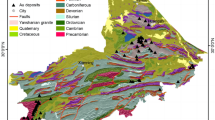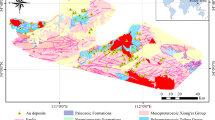Abstract
Deep learning algorithms (DLAs) are becoming popular tools for mineral prospectivity mapping. However, purely data-driven DLAs frequently ignore expert and domain knowledge, imposing difficulty in interpretability from a geological perspective. The efficient integration of geological knowledge into DLAs remains challenging in geosciences. In this study, a geologically constrained variational autoencoder (VAE) was proposed to map prospectivity for gold mineralization in the Baguio District of the Philippines. A spatial nonlinear correlation between an ore-forming controlling feature and locations of mineral deposits was built as part of the loss function for constructing a geologically constrained VAE. A comparative study of a geologically constrained and a traditional VAE demonstrated that the former can enhance the probabilities in areas with high potential for locating mineralization and increase the interpretability of the obtained results.









Similar content being viewed by others
References
Agterberg, F. P. (1989). Computer programs for mineral exploration. Science, 245, 76–81.
Agterberg, F.P., & Bonham-Carter, G.F. (1999). Logistic regression and weights of evidence modeling in mineral exploration. In: Proceedings of the 28th International Symposium on Applications of Computer in the Mineral Industry (APCOM), Golden, Colorado, pp. 483–490.
An, P., Moon, W. M., & Rencz, A. (1991). Application of fuzzy set theory to integrated mineral exploration. Canadian Journal of Exploration Geophysics, 27, 1–11.
Balce, G. R., Encina, R. Y., Momongan, A., & Lara, E. (1980). Geology of the Baguio district and its implications on the tectonic development of the Luzon Central Cordillera. Geology and Paleontology of Southeast Asia, 21, 265–287.
Bengio, Y. (2012). Deep learning of representations for unsupervised and transfer learning. Proceedings of ICML workshop on unsupervised and transfer learning. pp. 17–36.
Bonham-Carter, G. F., Agterberg, F.P., & Wright, D.F. (1989). Weights of evidence modelling: a new approach to mapping mineral potential. In: Agterberg, F.P., Bonham-Carter, G.F. (Eds.), Statistical Applications in the Earth Sciences. Geological Survey of Canada, Paper 89–9, pp. 171–183.
Bonham-Carter, G. F. (1994). Geographic information systems for geoscientists: Modelling with GIS (p. 398). Pergamon Press.
Carranza, E. J. M. (2008). Geochemical anomaly and mineral prospectivity mapping in GIS: Amsterdam. In M. Hale (Ed.), Handbook of exploration and environmental geochemistry (Vol. 11, p. 351). Elsevier.
Carranza, E. J. M. (2017). Natural resources research publications on geochemical anomaly and mineral potential mapping, and introduction to the special issue of papers in these fields. Natural Resources Research, 26, 379–410.
Carranza, E. J. M. (2021). Mineral Prospectivity Analysis. In B. Daya Sagar, Q. Cheng, J. McKinley, & F. Agterberg (Eds.), Encyclopedia of mathematical geosciences. Encyclopedia of earth sciences series. Springer.
Carranza, E. J. M., & Hale, M. (2000). Geologically-constrained probabilistic mapping of gold potential, Baguio district, Philippines. Natural Resources Research, 9, 237–253.
Carranza, E. J. M., & Hale, M. (2001). Logistic regression for geologically constrained mapping of gold potential, Baguio district, Philippines. Exploration and Mining Geology: Journal of the Geological Society of CIM, 10, 165–175.
Carranza, E. J. M., & Hale, M. (2002). Where are porphyry copper deposits spatially localized? A case study in Benguet province, Philippines. Natural Resources Research, 11, 45–59.
Carranza, E. J. M., & Hale, M. (2003). Evidential belief functions for data-driven geologically constrained mapping of gold potential, Baguio district, Philippines. Ore Geology Reviews, 22, 117–132.
Carranza, E. J. M., & Laborte, A. G. (2015). Data-driven predictive mapping of gold prospectivity, Baguio district, Philippines: Application of Random Forests algorithm. Ore Geology Reviews, 71, 777–787.
Carranza, E. J. M., Mangaoang, J. C., & Hale, M. (1999). Application of mineral exploration models and GIS to generate mineral potential maps as input for optimum landuse planning in the Philippines. Nature Resource Research, 8, 165–173.
Chang, C. I., & Chiang, S. S. (2002). Anomaly detection and classification for hyperspectral imagery. IEEE Transactions on Geoscience and Remote Sensing, 40, 1314–1325.
Chen, Y., & Wu, W. (2017). Mapping mineral prospectivity using an extreme learning machine regression. Ore Geology Reviews, 80, 200–213.
Chen, Y., Wu, W., & Zhao, Q. (2020). A bat algorithm-based data-driven model for mineral prospectivity mapping. Natural Resources Research, 29, 247–265.
Cooke, D. R., McPhail, D. C., & Bloom, M. S. (1996). Epithermal gold mineralization, Acupan, Baguio district, Philippines; geology, mineralization, alteration, and the thermochemical environment of ore deposition. Economic Geology and the Bulletin of the Society of Economic Geologists, 91, 243–272.
Deng, D. (2007). Content-based image collection summarization and comparison using self-organizing maps. Pattern Recognition, 40, 718–727.
Erfani, S. M., Rajasegarar, S., Karunasekera, S., & Leckie, C. (2016). High-dimensional and large-scale anomaly detection using a linear one-class SVM with deep learning. Pattern Recognition, 58, 121–134.
Fawcett, T. (2006). An introduction to ROC analysis. Pattern Recognition Letters, 27, 861–874.
Fernandez, H. E., & Damasco, F. V. (1979). Gold deposition in the Baguio gold district and its relationship to regional geology. Economic Geology, 74, 1852–1868.
Ford, A., Peters, K. J., Partington, G. A., Blevin, P. L., Downes, P. M., Fitzherbert, J. A., & Greenfield, J. E. (2019). Translating expressions of intrusion-related mineral systems into mappable spatial proxies for mineral potential mapping: Case studies from the Southern New England Orogen, Australia. Ore Geology Reviews, 111, 102943.
Ghassemian, H. (2016). A review of remote sensing image fusion methods. Information Fusion, 32, 75–89.
Gu, Y., Bao, Z., & Rui, Z. (2018). Prediction of shell content from thin sections using hybrid image process techniques. Journal of Petroleum Science and Engineering, 163, 45–57.
Kingma, D.P., & Welling, M. (2013). Auto-encoding variational bayes. arXiv preprint arXiv:1312.6114. Retrieved from https://arxiv.org/abs/1312.6114
LeCun, Y., Bengio, Y., & Hinton, G. (2015). Deep learning. Nature, 521, 436.
Li, S., Chen, J., Liu, C., & Wang, Y. (2021a). Mineral prospectivity prediction via convolutional neural networks based on geological big data. Journal of Earth Science, 32, 327–347.
Li, S., Chen, J., & Xiang, J. (2020). Applications of deep convolutional neural networks in prospecting prediction based on two-dimensional geological big data. Neural Computing and Applications, 32, 2037–2053.
Li, T., Zuo, R., Xiong, Y., & Peng, Y. (2021b). Random-drop data augmentation of deep convolutional neural network for mineral prospectivity mapping. Natural Resources Research, 30, 27–38.
Li, T., Zuo, R., Zhao, X., & Zhao, K. (2022). Mapping prospectivity for regolith-hosted REE deposits via convolutional neural network with generative adversarial network augmented data. Ore Geology Reviews, 142, 104693.
Li, W., Wu, G., & Du, Q. (2017). Transferred deep learning for anomaly detection in hyperspectral imagery. IEEE Geoscience and Remote Sensing Letters, 14, 597–601.
Luo, Z., Xiong, Y., & Zuo, R. (2020). Recognition of geochemical anomalies using a deep variational autoencoder network. Applied Geochemistry, 122, 104710.
Maggiori, E., Tarabalka, Y., Charpiat, G., & Alliez, P. (2017). Convolutional neural networks for large-scale remote-sensing image classification. IEEE Transactions on Geoscience and Remote Sensing, 55, 645–657.
Mayer-Schonberger, V., & Cukier, K. (2013). Big data: A revolution that will transform how we live, work and think. Houghton Mifflin Harcourt Publishing Company.
McMillan, M., Haber, E., Peters, B., & Fohring, J. (2021). Mineral prospectivity mapping using a VNet convolutional neural network. Leading Edge, 40, 99–105.
Meng, T., Jing, X., Yan, Z., & Pedrycz, W. (2020). A survey on machine learning for data fusion. Information Fusion, 57, 115–129.
Mitchell, A. H. G., & Leach, T. M. (1991). Epithermal gold in the Philippines: Island arc metallogenesis, geothermal systems and geology. Academic Press.
Moon, W. M. (1990). Integration of geophysical and geological data using evidential belief function. IEEE Transaction of Geoscience Remote Sensing, 28, 711–720.
Negnevitsky, M. (2002). Artificial intelligence: A guide to intelligent systems (p. 394). Addison Wesley/Pearson Education.
Porwal, A., Carranza, E. J. M., & Hale, M. (2006). A hybrid fuzzy weights-of-evidence model for mineral potential mapping. Natural Resources Research, 8, 27–35.
Richa, Mukerji, T., Mavko, G., & Keehm, Y. (2006). Image analysis and pattern recognition for porosity estimation from thin sections. SEG Technical Program Expanded Abstracts 2006 (pp. 1968–1972). Society of Exploration Geophysicists.
Rodriguez-Galiano, V. F., Chica-Olmo, M., & Chica-Rivas, M. (2014). Predictive modelling of gold potential with the integration of multisource information based on random forest: A case study on the Rodalquilar area, Southern Spain. International Journal of Geographical Information Science, 28, 1336–1354.
Shao, Z., & Cai, J. (2018). Remote sensing image fusion with deep convolutional neural network. IEEE Journal of Selected Topics in Applied Earth Observations and Remote Sensing, 11, 1656–1669.
Singer, D. A., & Kouda, R. (1996). Application of a feedforward neural network in the search for Kuruko deposits in the Hokuroku district, Japan. Mathematical Geology, 28, 1017–1023.
Sun, T., Li, H., Wu, K., Chen, F., Zhu, Z., & Hu, Z. (2020). Data-driven predictive modelling of mineral prospectivity using machine learning and deep learning methods: A case study from Southern Jiangxi Province, China. Minerals, 10, 102.
Tang, X., Jiang, Z., Jiang, S., & Li, Z. (2016). Heterogeneous nanoporosity of the Silurian Longmaxi formation shale gas reservoir in the Sichuan Basin using the QEMSCAN, FIB-SEM, and nano-CT methods. Marine and Petroleum Geology, 78, 99–109.
Taylor, R. B., & Steven, T. A. (1983). Definition of mineral resource potential. Economic Geology, 78, 1268–1270.
Wang, J., & Zuo, R. (2018). Identification of geochemical anomalies through combined sequential Gaussian simulation and grid-based local singularity analysis. Computers & Geosciences, 118, 52–64.
Wang, Z., & Zuo, R. (2022). Mineral prospectivity mapping using a joint singularity-based weighting method and long short-term memory network. Computers & Geosciences, 158, 104974.
Wang, Z., Zuo, R., & Zhang, Z. (2015). Spatial analysis of Fe deposits in Fujian province, China: Implications for mineral exploration. Journal of Earth Science, 26, 813–820.
Waters, P. J., Cooke, D. R., Gonzales, R. I., & Phillips, D. (2011). Porphyry and epithermal deposits and 40ar/39ar geochronology of the Baguio district, Philippines. Economic Geology and the Bulletin of the Society of Economic Geologists, 106, 1335–1363.
Wolfe, J. A. (1981). Philippine geochronology. Journal of the Geological Society of the Philippines, 35, 1–30.
Wolfe, J. A. (1988). Arc magmatism and mineralization in north Luzon and its relationship to subduction at the east Luzon and north manila trenches. Journal of Southeast Asian Earth Sciences, 2, 79–93.
Xiong, Y., & Zuo, R. (2018). GIS-based rare events logistic regression for mineral prospectivity mapping. Computers & Geosciences, 111, 18–25.
Xiong, Y., & Zuo, R. (2021). Robust feature extraction for geochemical anomaly recognition using a stacked convolutional denoising autoencoder. Mathematical Geosciences. https://doi.org/10.1007/s11004-021-09935-z
Xiong, Y., Zuo, R., & Carranza, E. J. M. (2018). Mapping mineral prospectivity through big data analytics and a deep learning algorithm. Ore Geology Reviews, 102, 811–817.
Xiong, Y., Zuo, R., Luo, Z., & Wang, X. (2021). A physically constrained variational autoencoder for geochemical pattern recognition. Mathematical Geosciences. https://doi.org/10.1007/s11004-021-09979-1
Xu, Y., Li, Z., Xie, Z., Cai, H., Niu, P., & Liu, H. (2021). Mineral prospectivity mapping by deep learning method in Yawan-Daqiao area, Gansu. Ore Geology Reviews, 138, 104316.
Yang, N., Zhang, Z., Yang, J., Hong, Z., & Shi, S. (2021). A convolutional neural network of GoogLeNet applied in mineral prospectivity prediction based on multi-source geoinformation. Natural Resources Research. https://doi.org/10.1007/s11053-021-09934-1
Yin, B., Zuo, R., & Xiong, Y. (2021). Mineral prospectivity mapping via gated recurrent unit model. Natural Resources Research. https://doi.org/10.1007/s11053-021-09979-2
Yousefi, M., Kreuzer, O. P., Nykänen, V., & Hronsky, J. M. A. (2019). Exploration information systems—A proposal for the future use of GIS in mineral exploration targeting. Ore Geology Reviews, 111, 103005.
Zhang, S., Carranza, E. J. M., Wei, H., Xiao, K., Yang, F., Xiang, J., Zhang, S., & Xu, Y. (2021). Data-driven mineral prospectivity mapping by joint application of unsupervised convolutional auto-encoder network and supervised convolutional neural network. Natural Resources Research, 30, 1011–1031.
Zuo, R. (2016). A nonlinear controlling function of geological features on magmatic–hydrothermal mineralization. Scientific Reports, 6, 1–5.
Zuo, R. (2020). Geodata science-based mineral prospectivity mapping: A review. Natural Resources Research, 29, 3415–3424.
Zuo, R., & Carranza, E. J. M. (2011). Support vector machine: A tool for mapping mineral prospectivity. Computers & Geosciences, 37, 1967–1975.
Zuo, R., Cheng, Q., & Agterberg, F. P. (2009). Application of a hybrid method combining multilevel fuzzy comprehensive evaluation with asymmetric fuzzy relation analysis to mapping prospectivity. Ore Geology Reviews, 35, 101–108.
Zuo, R., Kreuzer, O. P., Wang, J., Xiong, Y., Zhang, Z., & Wang, Z. (2021). Uncertainties in GIS-based mineral prospectivity mapping: Key types, potential impacts and possible solutions. Natural Resources Research, 30, 3059–3079.
Zuo, R., Zhang, Z., Zhang, D., Carranza, E. J. M., & Wang, H. (2015). Evaluation of uncertainty in mineral prospectivity mapping due to missing evidence: A case study with skarn-type Fe deposits in Southwestern Fujian Province, China. Ore Geology Reviews, 71, 502–515.
Acknowledgments
This study was supported by the National Natural Science Foundation of China (Grant No. 42172326). We thank six reviewers’ comments and suggestions which helped us improve this study.
Author information
Authors and Affiliations
Corresponding author
Rights and permissions
About this article
Cite this article
Zuo, R., Luo, Z., Xiong, Y. et al. A Geologically Constrained Variational Autoencoder for Mineral Prospectivity Mapping. Nat Resour Res 31, 1121–1133 (2022). https://doi.org/10.1007/s11053-022-10050-x
Received:
Accepted:
Published:
Issue Date:
DOI: https://doi.org/10.1007/s11053-022-10050-x




